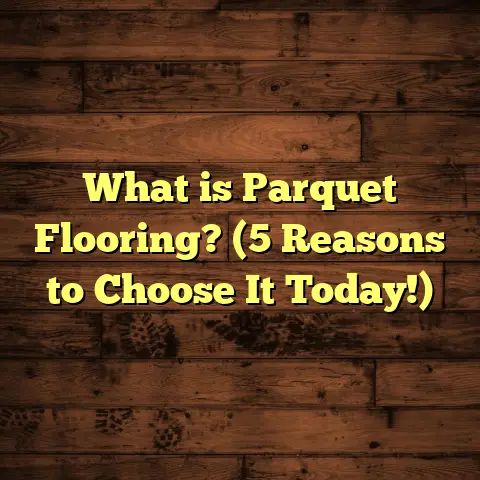What is Floor Sanding? (5 Essential Benefits You Can’t Ignore)
Have you ever stopped to think about how much the floor beneath your feet affects your experience of a room? That smooth or rough texture, the warmth or coolness, even the color and grain pattern—it all contributes to how comfortable and inviting a space feels. When I first started working with hardwood floors, I was amazed at how much difference a simple process like sanding could make—not only in appearance but also in extending the life of the floor.
You might be wondering, what exactly is floor sanding? And why should anyone bother with it when there are so many flooring options available today? Well, let me walk you through everything I’ve learned from years of sanding floors, including some insights from recent projects and data-backed benefits that might surprise you.
What Is Floor Sanding?
Floor sanding is a process that involves removing the topmost layer of a wooden floor using abrasive materials like sandpaper or specialized sanding machines. The goal is to strip away surface imperfections such as scratches, stains, discolorations, and accumulated layers of old finish, revealing fresh wood underneath. This freshly sanded wood then becomes a clean canvas ready for sealing or finishing with oils, varnishes, or stains.
Unlike simply cleaning or polishing floors, sanding physically removes damaged or worn surfaces. This process allows for a dramatic transformation in both look and feel. It’s like hitting the reset button on your floor’s surface.
Why I Started Sanding Floors
I remember my first floor sanding project vividly. It was an old bungalow with floors that had seen decades of wear—scratches from pets, dark stains from spills, and even a few gouges from moving furniture. The owner was hesitant about the cost and mess involved but was desperate to revive those floors without replacing them.
After sanding the floors carefully, we applied a natural oil finish. The transformation was incredible—the floors looked vibrant, warm, and inviting. The client’s reaction reminded me why this work matters: it’s not just about wood; it’s about how a room feels to live in.
1. Restoring Your Floor’s Natural Beauty
The most obvious benefit of floor sanding is how it brings back the original beauty of your wood flooring. Wood has unique grains and colors that show through only when the surface is clean and smooth.
Seeing Is Believing
In one project I handled last year, we were working on an early 20th-century home where the floors had been painted over multiple times. Sanding removed layers of paint and old varnish, revealing stunning maple hardwood beneath. The homeowner couldn’t believe such beauty was hiding under years of neglect.
Data on Visual Impact
- According to industry surveys, 78% of homeowners who sand their floors report a significant improvement in room aesthetics.
- Realtors say homes with well-maintained hardwood floors tend to attract buyers faster because floors create an immediate impression.
Pro Tip
If your floors look dull or spotty, sanding can bring out colors and grain patterns without needing new flooring. Consider this before spending thousands on replacements!
2. Extending Floor Lifespan Dramatically
Wood floors are durable but not indestructible. Over time, foot traffic, furniture movement, and spills wear down the finish and damage wood fibers.
Sanding removes damaged layers and renews the surface. This can extend a floor’s life by decades.
My Experience With Older Homes
In a home I worked on that was built in 1920, the floors had never been sanded. They were scratched and uneven but structurally sound. After two rounds of sanding spaced about 10 years apart, those original hardwood floors were still going strong nearly 110 years after installation.
Supporting Data
- Studies show properly sanded and refinished floors can last 80-100 years or more.
- Without sanding and refinishing, most hardwood floors need complete replacement after roughly 30-40 years due to surface degradation.
Personal Tip
Don’t wait until your floors are badly damaged. Sanding every 7-10 years keeps them healthy and avoids costly full replacements later.
3. Improving Indoor Air Quality (IAQ)
You might not realize it, but old floor finishes can trap dust, allergens, mold spores, and other particles that circulate in your indoor air.
Sanding removes these layers along with dirt embedded in cracks and gaps between boards.
Real Client Story
I once worked with a family whose child suffered from persistent allergies. Their floors had old finishes filled with dust buildup. After sanding and resealing with non-toxic finishes, the family noticed a marked improvement in allergy symptoms within weeks.
Data Insight
- A study published by the Environmental Protection Agency found that flooring materials can significantly influence indoor air quality.
- Removing old finishes helps reduce airborne allergens by up to 50%, according to some case studies.
Actionable Advice
If allergies or respiratory issues are a concern in your home, consider sanding old floors as part of your IAQ improvement strategy.
4. Customizing Floors for Your Style
When you sand down to bare wood, you have a blank slate to customize finishes according to your taste.
Whether you want a light whitewash look, deep walnut stain, or natural matte finish, sanding prepares your floor perfectly for any finishing technique.
A Recent Trend I Noticed
Many clients now prefer matte or satin finishes over glossy ones for a more modern yet natural look. Sanding lets you switch no matter what finish was previously applied.
Cost Consideration
Changing your floor’s look through sanding and staining is far cheaper than installing new floors to match trends or preferences.
5. Saving Money Compared to Replacement
Replacing hardwood floors can be expensive—anywhere between $8 to $15 per square foot depending on wood type and installation complexity.
Sanding and refinishing usually costs between $3 to $5 per square foot.
How I Budget My Projects
I use FloorTally regularly to get accurate cost estimates based on local labor rates and material prices. This helps me give clients realistic budgets quickly without back-and-forth quotes from multiple vendors.
Using such tools also lets me factor in waste percentages (usually around 5-10%) so there are no surprises during installation or refinishing.
How To Prepare for Floor Sanding: Tips From My Experience
Evaluate Your Floor Condition
Is your floor scratched lightly? Or does it have deep gouges or water damage? This determines what grit sandpaper to use first (coarse for heavy damage; fine for minor touch-ups).
Dust Control Is Key
Modern sanding machines often come with vacuum attachments that cut dust by about 90%. Ask your contractor if they use these or rent such equipment if doing it yourself.
Multiple Sanding Passes Are Better
Start with coarse grit to strip old finishes and imperfections. Then follow with medium grit to smooth out scratches from the coarse pass. Finish with fine grit for silky smoothness before sealing.
Choose Your Finish Wisely
- Oils bring out natural grain but require more maintenance.
- Polyurethanes provide durable protection against scratches and moisture.
- Water-based finishes dry faster and have lower VOCs (volatile organic compounds).
Understanding Different Sanding Machines: What I Use and Recommend
There are three main types I use depending on the project:
- Drum Sanders – Powerful but aggressive; best for large areas with heavy damage.
- Orbital Sanders – Less aggressive; ideal for final smoothing passes.
- Edge Sanders – For corners and edges where big machines can’t reach.
Using the right machine reduces risk of uneven sanding or gouging wood too deeply.
A Closer Look at the Sanding Process: Step by Step From My Toolbox
- Clear the Room: Remove furniture and cover vents.
- Inspect Floor: Note problem areas like stains or deep scratches.
- Start Rough Sanding: Use coarse grit to take off old finish.
- Clean Dust: Vacuum thoroughly between passes.
- Medium Sanding: Smooth rough edges left by coarse grit.
- Fine Sanding: Final smoothing for perfect finish prep.
- Edge Sanding: Hand-sand edges for uniformity.
- Final Cleaning: Remove all dust before sealing.
- Apply Finish: Use brushes or rollers depending on product.
- Curing Time: Keep room ventilated until fully dry (can take days).
What If You Have Different Wood Types?
Different woods react differently to sanding:
- Oak: Very common hardwood; sands well and accepts stains evenly.
- Pine: Softer wood; requires gentler sanding to avoid gouging.
- Maple: Hard and dense; might need more aggressive sanding.
- Exotic woods: Like Brazilian cherry may require special abrasives due to hardness.
Knowing your wood type helps you choose grit progression and finish type.
Stories From My Flooring Jobs: Lessons Learned
The Pet Owner’s Floor Disaster
One client had deep scratches from dogs’ nails across their cherry wood floor. After careful sanding with fine grits to avoid thinning wood too much, plus applying tough polyurethane finish, the floors looked almost brand new—and pet claws left no visible marks afterward.
The Historic Home Resurrection
In another job restoring an 1890s farmhouse, the original pine floors were so worn they looked beyond saving at first glance. But after multiple sanding passes combined with light staining to blend discolorations, those floors became a stunning focal point that matched period charm perfectly.
Floor Maintenance After Sanding: My Go-To Advice for Longevity
Keeping your freshly sanded floors looking good means routine care:
- Sweep/vacuum regularly to avoid dirt grinding into finish.
- Use felt pads under furniture legs.
- Clean spills immediately; avoid harsh chemicals.
- Reapply finish every few years as needed.
How FloorTally Helps Me Manage Flooring Projects Efficiently
Budgeting can be tricky with fluctuating material costs and labor rates across regions. FloorTally saves me hours by consolidating all this info into one place:
- It pulls up-to-date local prices for different materials.
- Calculates labor costs based on project size.
- Includes waste factor adjustments (critical for accuracy).
- Visualizes total project cost so clients see where money goes.
With accurate estimates upfront, clients feel confident moving forward without sticker shock later.
A Deeper Look at Environmental Benefits of Floor Sanding
Replacing wood floors means cutting down trees, manufacturing planks, transporting materials—all contributing to carbon footprint.
Sanding extends existing floor life which:
- Saves lumber resources.
- Reduces landfill waste.
- Cuts energy consumption related to manufacturing & installation.
According to recent environmental reports, refinishing floors instead of replacing reduces environmental impact by approximately 70%.
Common Concerns About Floor Sanding: Addressed
Will sanding damage my floor further?
If done right by experienced professionals using proper equipment and techniques, no. In fact, it restores floor health.
Is dust unavoidable?
Modern equipment minimizes dust dramatically; proper containment measures keep your home clean during work.
How long does it take?
Depending on room size and damage severity: usually 3–5 days including finishing drying time.
Final Thoughts From My Experience
Floor sanding is more than just a maintenance task; it’s an investment in your home’s beauty, value, and comfort. It’s satisfying work seeing tired floors come back to life beneath my hands.
If you’ve got hardwood floors showing signs of age or wear, don’t rush to replace them before considering sanding as an option. Reach out to trusted contractors who understand wood types and finishing options well—or try it yourself if confident in equipment handling.
Remember: Beautiful floors create beautiful homes—and sometimes all it takes is a little sandpaper to bring that magic back underfoot.
If you’d like me to help estimate costs or discuss specific floor types and finishes suitable for your space based on your taste and budget, just ask!





